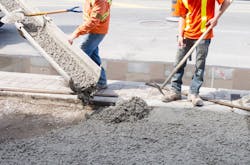As Softwood Lumber Falls, Concrete Prices Soar to New Highs
Building material prices dropped 0.3% in November, according to the latest Producer Price Index (PPI) report, which has decreased five of six months for the first time since 2015. Though the PPI for goods inputs to residential construction fell 0.8% in November, the price index of services inputs to residential construction rose 0.6%, the second straight monthly increase after six consecutive months of falling prices.
The PPI for softwood lumber (seasonally adjusted) fell 0.1% in November for the seventh decrease in the past eight months, falling 42.2% from its March peak. On the contrary, ready-mix concrete (RMC) prices increased 1.1% in November for a year-to-date gain of 10.7%, the largest November YTD increase in the series’ 34-year history, NAHB Eye on Housing reports.
The monthly increase in the national data was entirely driven by a 3.8% price increase in the Midwest. Prices edged up in the Northeast and West regions while declining in the South. The West has experienced the largest increase since January 2021 (+27.7%) while the smallest increase over the period has been in the Northeast.
Unlike softwood lumber, volatility continues to be an issue in the RMC market and is just shy of the record high set in the middle of the housing boom.
